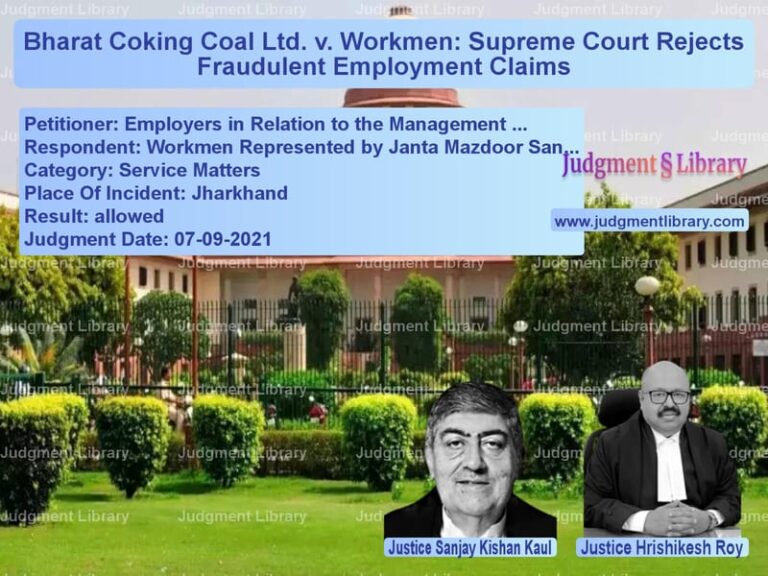Supreme Court Acquits Murder Convict Due to Lack of Conclusive Evidence
The Supreme Court of India has overturned the conviction of Raja Naykar, who was sentenced to life imprisonment for murder. The Court found that the prosecution failed to establish guilt beyond reasonable doubt, primarily because the case relied solely on circumstantial evidence. The ruling in Raja Naykar vs. State of Chhattisgarh underscores the legal principle that suspicion, no matter how strong, cannot replace proof in criminal cases.
Background of the Case
On October 21, 2009, the half-burnt body of Shiva alias Sanwar was discovered behind Baba Balak Nath temple near Shastri Nagar ground, Chhattisgarh. The police registered an FIR against unknown persons based on information provided by a witness, Pramod Kumar.
The prosecution claimed that Shiva had murdered the appellant’s brother, Mohan. Seeking revenge, Raja Naykar allegedly stabbed Shiva 24 times, wrapped his body in a blanket, and attempted to burn it to destroy evidence.
Charges and Trial
The accused was charged with:
- Section 302 IPC – Murder
- Section 201 IPC – Causing disappearance of evidence
- Section 120B IPC – Criminal conspiracy
The Additional Sessions Judge, Durg, convicted the appellant, and the Chhattisgarh High Court upheld the conviction in CRA No. 223 of 2012. The appellant then approached the Supreme Court.
Arguments by the Appellant (Raja Naykar)
The appellant, through his counsel, contended:
- There was no direct evidence linking him to the murder.
- The prosecution relied entirely on circumstantial evidence.
- The body was unidentifiable, and the prosecution failed to prove that it belonged to Shiva.
- The alleged recovery of weapons and bloodstained clothes was not credible.
- The High Court and Trial Court based their conclusions on conjecture rather than solid proof.
Arguments by the Respondent (State of Chhattisgarh)
The prosecution argued:
- The appellant had a strong motive for the murder.
- The forensic report confirmed human blood on the recovered dagger.
- The accused attempted to destroy evidence by burning the body.
- The recovery of the body and weapons at the instance of the appellant strengthened the case.
Supreme Court’s Key Observations
The Supreme Court noted that the case was based entirely on circumstantial evidence. Referring to Sharad Birdhichand Sarda vs. State of Maharashtra (1984), the Court reiterated the five principles of circumstantial evidence:
(1) The circumstances must be fully established.
(2) The facts must be consistent only with the guilt of the accused.
(3) The circumstances must be of a conclusive nature.
(4) Every other hypothesis except the accused’s guilt must be ruled out.
(5) The chain of evidence must be complete, showing that the accused alone committed the act.
Key Findings
- Identification of the Body: The prosecution failed to conclusively prove that the recovered body belonged to Shiva.
- Recovery of Weapon: The dagger was found in an open space accessible to all, making it unreliable as evidence.
- Forensic Report: While the dagger had human blood, the prosecution did not prove that the blood matched the deceased.
- Clothes Recovery: The bloodstained clothes were allegedly recovered from the house of the appellant’s sister-in-law days after the crime, making it unlikely they had not been removed earlier.
Supreme Court’s Judgment
The Supreme Court ruled:
- The conviction was based on weak circumstantial evidence.
- Mere suspicion could not replace concrete proof.
- The prosecution failed to establish a direct link between the accused and the crime.
- The High Court’s findings on the accused’s lack of explanation under Section 313 CrPC were misplaced.
- The accused was entitled to the benefit of the doubt.
- The conviction was quashed, and the appellant was ordered to be released immediately.
Implications of the Judgment
This ruling has far-reaching implications:
- Reaffirmation of Legal Principles: The verdict reinforces that convictions must be based on evidence, not suspicion.
- High Burden of Proof in Criminal Cases: The ruling ensures that circumstantial evidence must be conclusive.
- Protection Against Wrongful Convictions: The judgment prevents innocent persons from being punished based on inadequate evidence.
Conclusion
The Supreme Court’s decision in Raja Naykar vs. State of Chhattisgarh highlights the critical role of substantive proof in criminal trials. It ensures that courts uphold the highest standards of justice, ensuring no one is wrongfully convicted based on weak circumstantial evidence.
Petitioner Name: Raja Naykar.Respondent Name: State of Chhattisgarh.Judgment By: Justice B.R. Gavai, Justice Sandeep Mehta.Place Of Incident: Durg, Chhattisgarh.Judgment Date: 24-01-2024.
Don’t miss out on the full details! Download the complete judgment in PDF format below and gain valuable insights instantly!
Download Judgment: raja-naykar-vs-state-of-chhattisgar-supreme-court-of-india-judgment-dated-24-01-2024.pdf
Directly Download Judgment: Directly download this Judgment
See all petitions in Murder Cases
See all petitions in Bail and Anticipatory Bail
See all petitions in Custodial Deaths and Police Misconduct
See all petitions in Judgment by B R Gavai
See all petitions in Judgment by Sandeep Mehta
See all petitions in allowed
See all petitions in Quashed
See all petitions in supreme court of India judgments January 2024
See all petitions in 2024 judgments
See all posts in Criminal Cases Category
See all allowed petitions in Criminal Cases Category
See all Dismissed petitions in Criminal Cases Category
See all partially allowed petitions in Criminal Cases Category







